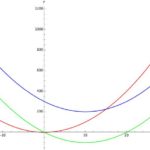Eigenvalues of Real Skew-Symmetric Matrix are Zero or Purely Imaginary and the Rank is Even

Problem 269
Let $A$ be a real skew-symmetric matrix, that is, $A^{\trans}=-A$.
Then prove the following statements.
(a) Each eigenvalue of the real skew-symmetric matrix $A$ is either $0$ or a purely imaginary number.
(b) The rank of $A$ is even.
Sponsored Links
Contents
Proof.
(a) Each eigenvalue of the real skew-symmetric matrix $A$ is either $0$ or a purely imaginary number.
Let $\lambda$ be an eigenvalue of $A$ and let $\mathbf{x}$ be an eigenvector corresponding to the eigenvalue $\lambda$. That is, we have
\[A\mathbf{x}=\lambda \mathbf{x}.\]
Multiplying by $\bar{\mathbf{x}}^{\trans}$ from the left, we have
\begin{align*}
\bar{\mathbf{x}}^{\trans}A\mathbf{x}=\lambda \bar{\mathbf{x}}^{\trans} \mathbf{x}=\lambda ||\mathbf{x}||^2. \tag{*}
\end{align*}
Note that the left hand side $\bar{\mathbf{x}}^{\trans}A\mathbf{x}$ is the dot (inner) product of $\bar{\mathbf{x}}$ and $A\mathbf{x}$. Since the dot product is commutative, we have
\begin{align*}
&\text{The left hand side of (*)}\\
&=\bar{\mathbf{x}}^{\trans}A\mathbf{x}=(A\mathbf{x})^{\trans}\bar{\mathbf{x}}\\
&=x^{\trans}A^{\trans}\bar{\mathbf{x}}.
\end{align*}
Since $A$ is skew-symmetric, we have $A^{\trans}=-A$. Substituting this into the above equality, we have
\begin{align*}
&\text{The left hand side of (*)}\\
&=x^{\trans}A^{\trans}\bar{\mathbf{x}}=-\mathbf{x}^{\trans}A\bar{\mathbf{x}}
\end{align*}
Taking conjugate of $A\mathbf{x}=\lambda\mathbf{x}$ and use the fact that $A$ is real, we have
\[A\bar{\mathbf{x}}=\bar{\lambda}\bar{\mathbf{x}}.\]
Thus, we have
\begin{align*}
&\text{The left hand side of (*)}\\
&=-\mathbf{x}^{\trans}A\bar{\mathbf{x}}\\
&=-\mathbf{x}^{\trans}\bar{\lambda}\bar{\mathbf{x}}=-\bar{\lambda}||\mathbf{x}||^2.
\end{align*}
Therefore comparing the left and right hand sides of (*) yields
\[-\bar{\lambda}||\mathbf{x}||^2=\lambda ||\mathbf{x}||^2.\]
Since $\mathbf{x}$ is an eigenvector, it is nonzero by definition. Thus $||\mathbf{x}||\neq 0$.
Hence we have
\[-\bar{\lambda}=\lambda,\]
and this implies that $\lambda$ is either $0$ or purely imaginary number.
(To see this, let $\lambda=a+ib$, where $a, b\in \R$. Then
\[-\bar{\lambda}=-a+ib=a+ib=\lambda\]
implies $a=0$, thus $\lambda=bi$.)
Remark: Another similar proof is to take conjugate of (*).
(b) The rank of $A$ is even
From part (a), we know that the eigenvalues of $A$ are $0$ or purely imaginary.
Thus if $\lambda$ is a purely imaginary eigenvalue of $A$, then its conjugate $\bar{\lambda}=-\lambda$ is also an eigenvalue of $A$ since $A$ is a real matrix.
Thus, nonzero eigenvalues come in pairs $\lambda, -\lambda$ (and their algebraic multiplicities are the same).
Let
\[\lambda_1, -\lambda_1, \lambda_2, -\lambda_2, \dots, \lambda_k, -\lambda_k\]
be nonzero eigenvalues of $A$.
Since a real skew-symmetric matrix is normal, it is diagonalizable (by a unitary matrix).
Thus there exists an invertible matrix $P$ such that
\begin{align*}
&P^{-1}AP=\\
&\diag\begin{bmatrix}
\lambda_1 & -\lambda_1 & \lambda_2 & -\lambda_2 & \dots &\lambda_k &-\lambda_k & 0 &\dots 0
\end{bmatrix},
\end{align*} where $\diag[a_1,a_2,\dots, a_n]$ denotes the $n\times n$ matrix whose diagonal entries are $a_1, a_2, \dots, a_n$ and all the off diagonal entries are zero.
Since $P$ is an invertible matrix, the rank of $A$ is the same as the rank of the diagonal matrix on the right-hand side, which is easily seen to be $2k$.
Thus the rank of $A$ is $2k$, and we have proved that the rank of the real skew-symmetric matrix $A$ is even.
Related Question.
As an application of this problem, try the following problem.
For a proof, see the post↴
If $A$ is a Skew-Symmetric Matrix, then $I+A$ is Nonsingular and $(I-A)(I+A)^{-1}$ is Orthogonal.
For a proof, check out the post ↴
The Determinant of a Skew-Symmetric Matrix is Zero.
More Eigenvalue and Eigenvector Problems
Problems about eigenvalues and eigenvectors are collected on the page:
 Add to solve later
Add to solve later
Sponsored Links

















3 Responses
[…] of a skew-symmetric matrix are either $0$ or purely imaginary numbers. (See the post “Eigenvalues of Real Skew-Symmetric Matrix are Zero or Purely Imaginary and the Rank is Even” for a proof of this […]
[…] For a proof, see the post “Eigenvalues of Real Skew-Symmetric Matrix are Zero or Purely Imaginary and the Rank is Even“. […]
[…] each eigenvalue of a skew-symmetric matrix is either $0$ or purely imaginary. (See the post “Eigenvalues of Real Skew-Symmetric Matrix are Zero or Purely Imaginary and the Rank is Even“.) Also if the degree of the matrix is odd, it has $0$ as an eigenvalue. (See the post […]